Now that she has established herself as the greatest woman choreographer and contends for the title of greatest living choreographer, Anna Teresa de Keersmaeker has embarked on the very sensible route of revision of her older work along with the creation of new works. For the old work to go into the canon it must be seen by the new critics. Back in the 1980’s there was only a small group of people who knew how important de Keersmaeker’s oeuvre would become.
Happily Vienna – thanks to the tireless efforts of ImPulsTanz and Karl Regensburger who have been de Keersmaeker’s oldest and most steadfast co-producers – is a principal stop on all of de Keersmaeker’s roads so we get to see both the dance history and her new creations.
In December we saw Un moto di gioia, a full evening piece from 1992.
This time under the name Nacht we saw three smaller works, from the Rosas repertoire from 1986 to 1995. Musically the works were unified as compositions for quartets. All of them were played live. Live music is the life blood of dance. Tonight’s show demonstrated how much better it is to offer audiences a live quartet than a piped orchestra.
Quartett Nr. 4 was composed by Bela Bartok in 1928 and premiered in Brussels in the Théâtre CBA in 1986.
The Great Fugue in B-Major is Ludwig van Beethoven’s master work from 1825. Rosas dance work premiered in 1992 in the Hallen van Schaerbeek.
A Clear Night (Verklärte Nacht) is composer Arnold Schönberg’s innovative work of 1899, foreshadowing the work of Stravinsky and Rachmaninnov. Rosas piece premiered in 1995 in Théâtre de la Monnaie in Brussels. The move to Théâtre de la Monnaie can be considered to be the year when de Keersmaeker formally arrived with full institutional support.
De Keersmaeker’s development as a choreographer is apparent in the three pieces, performed here in chronological order.
De Keersmaeker herself still performs in Quartett Nr. 4 which is no small accomplishment considering that the piece is 20 years old and she left dance school in 1980 (before many of her current troupe were born). Almost miraculously she keeps good company with her three danseuses, even leading the group. While de Keersmaeker dances as well or better than any of them she is missing a certain playfulness or flirtationess in her attitude and some tiny snap in her movement (Elizaveta Penkova particularly excelled in playfulness, bringing joy to the stage). Still de Keersmaeker’s steps are beautiful, her figure ever girlish. One would be hard pressed to guess either her age or that she is a mother.

Quartett 4 – Bela Bartok- Anna Teresa de Keersmaeker
The piece itself is a simple one. The quartet is onstage with rows of toned down lights overhead. The stage a simple black. The four women dance together, both slowly and more quickly with wild leaps, ever in pace with the music. Bartok’s music itself is glorious, the musical highlight of the evening for me.
Quartet No. 4 takes us to the origins of dance: music and dancers and an audience.

Quartett Nr. 4 Elisaveta Penkova, Tale Dolven – Taka Shamato – Mystery girl
This is de Keersmaeker’s signature Rosas proposition. No men. Women in perfect sync to music. Purity of movement something like Balanchine. But also working the floor.
All that one could criticize this piece for is the absence of a strong emotional line apart from the music.
Die Grosse Fugue is quite different. A very large group, just two women. The musical quartet remains on stage behind the musicians. All of the group, including the women are clad in black evening suits and white shirts.
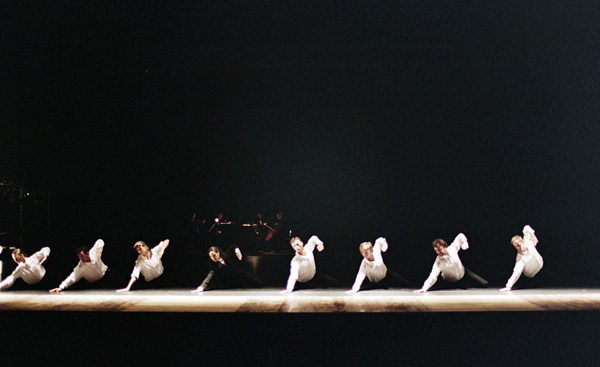
Die Grosse Fugue | Beethoven – Rosas
In the past, I hadn’t really noticed the Rosas men (Salvo Sanchis in A Love Supreme excepted) as much as the women, but in Beethoven’s Great Fugue, de Keersmaeker shows her ability to work with men as well. She has them doing cartwheels, leaps, rolls. The men are elegantly clad. The violence and power of movement while not approaching Vanderkeybus goes in that direction.
The storyline is difficult to decipher. The two women Kaya Kolodziejczyk and Moya Michael at one point lead the group and take off not only their jackets, but their topshirts remaining clad in white t-shirts.
Both Kolodziecjzyk acquit themselves well. Kaya Kolodziejcyk is one of those special artists whose verve fills a theatre. Of the men, particularly notable were Igor Shyshko and Mark Lorimer: Igor Shyshko for his long limbs and quickness, Mark Lorimer for his expressive and somewhat tragic mien. For some peculiar reason, Shyshko sports a mullet but his dancing is good enough to forgive him even that transgression of taste.
I could not decipher the meaning of the two women, rather than one. Amusingly enough, when I had the chance to speak with some of the dancers after the show, they told me Grand Fugue was originally performed with one woman. But there were not enough men in the company for this tour so one of the roles was transposed and some small alterations made to accommodate two women. I asked for a clear storyline – according to the dancers there isn’t one.
In the end, the Great Fugue is austere and tasteful: intelligent movement to exceptionally beautiful music. The audience responded to the first part of the evening with warmth and enthusiasm.
After the intermission the quartet was moved from the stage and put into the pit. They became six. Instead on stage we had seven full height birch tree trunks. Blood red leaves spread out in four or five diagonal lines across the stage. At the beginning we see seven or eight dancers standing under the tree trunks. This atmospheric setting was the creation of Gilles Aillaud with the help of Vinicio Cheli on lights and credit to Rudy Sabounghi for costumes. The costumes are dresses and suits which are of no absolutely clear epoch but definitely Europe pre-World War II.
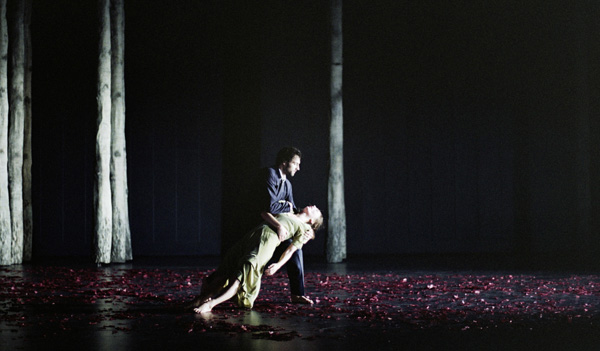
Verklärte Nacht | Schonberg Rosas | Elizaveta Penkóva – Bostjan Antoncic
Both the musical composition and the ballet for Clear Night are based on a story by Richard Dehmel. The story is of a woman and her new lover in the woods. The woman tells the man that she is pregnant with another man’s child. She is filled with regret and guilt. To her surprise, he answers that he will accept the child she bears as his own.
On this powerful libretto, Schönberg wrote his powerful score. Clear Night is so overwhelmingly emotional that it can be difficult sitting through the string sections. One has the same feeling of being smothered in the music as in some Hollywood film scores (derivative of Schönberg’s original).
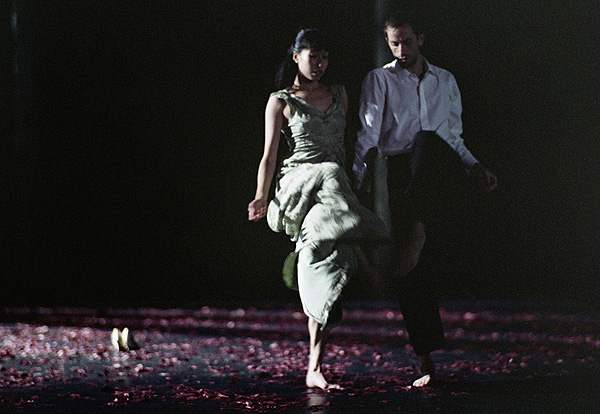
Verklärte Nacht | Schonberg Rosas | Tala Shamato – Mark Lorimer
What de Keersmaeker does with this original dialogue is create six couples, each one of which mirrors one part of the emotional discussion between the pair. All of the dancers do well. The most moving pair was Elizaveta Penkóva and Bostan Antoncic. Penkóva has the pleasure of reacting to the news from her lover that he accepts and welcomes her coming child. Her joy is palpable in her whole body. Penkóva is from Russia. While she studied in the West, she seems to have the same astonishing gift for emotional projection through movement historically present in the performances of her compatriots in the Bolshoi Theatre. Penkóva is very quick and light in her movements.

Verklärte Nacht | Schonberg Rosas | Elizaveta Penkóva – Bostjan Antoncic
Antoncic is both a fine dancer and enjoys matinée idol looks. He is tall with thick dark hair and strong eyebrows and a very red mouth. He is perhaps more emotionally reserved than need be but perhaps he was understating his case here to give Penkóva’s character full latitude to express her joy. Otherwise Zsusza Rozsavölgy was exceptionally expressive in her section. Her movement was more agitated and nervous than Penkóva’s. Perhaps Rozsavölgy’s roll was to reveal her situation to her new lover.
The only difficulty I had with Verklärte Nacht was the décor and costumes. While they were very well done, so many Second World War/Holocaust pieces have taken place in a forest with tragic dances between couples, that when they started shedding their clothes, I was unsure if this wasn’t another one of the same. The blood red leaves and the birch trees had me almost convinced. But at the time of the creation in 1995, it’s not certain that the European forest/holocaust motif equation was so pronounced. Forests, birch trees and couples should be timeless. De Keersmaeker could rid the piece of the Second World War overtones by making the costumes either more pronouncedly nineteenth century or more modern.
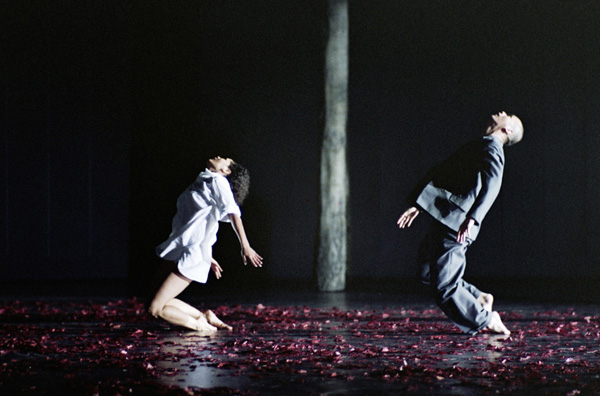
Verklärte Nacht | Moya Michael – Kosi Hidama
Birch Trees, Bloody Leaves, Undressed in the woods WWII motif
The musicians from the Duke Quartet were faultless in each episode, making it a ballet that could have been a concert.
Audience reaction to Clear Night was overwhelming. Rosas were brought back on stage for five curtain calls. Despite the elegant dress and visible sophistication of the evening’s chic public, Rosas had them hooting and hollering.
A splendid evening.
Anna Teresa de Keersmaeker will be back in Vienna this summer with a new work Sisters at ImPulsTanz. A duet with Fumiyo Ikeda created by Vincent Dunoyer with the help of several ex-Rosas dancers interpreting in signature Rosas style. de Keersmaeker is responsible for her own choreography in the duet, answering Fumiyo Ikeda’s.

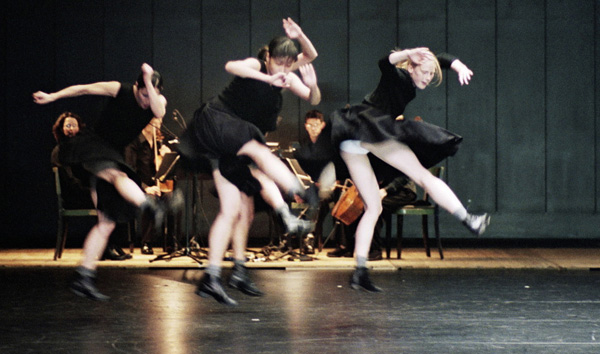
[…] danst Rosas is a historical work, the second mainstage full length work by then young choreographer Anna Teresa De Keersmaeker in 1982. One of the performances which moved me the most in my life is Rosas’s A Love Supreme […]
The mystery girl on picture 2 is Cynthia Loemij!